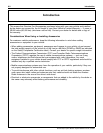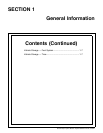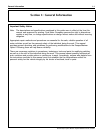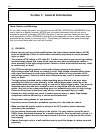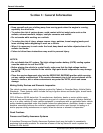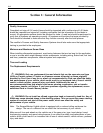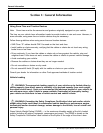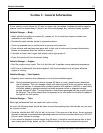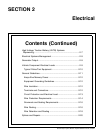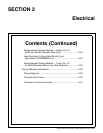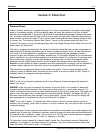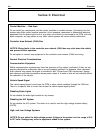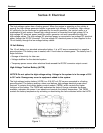
1-6 General Information
Section 1: General Information
Gross Axle Weight Rating (GAWR) — is the maximum allowable weight that can be carried by a
single axle (front or rear). These numbers are shown on the Safety Compliance Certification Label
located on the B-pillar or the edge of the driver’s door. The total load on each axle must never
exceed its GAWR.
WARNING: Do not use replacement tires with lower load carrying capacities than the
original tires because they may lower the vehicle’s Gross Vehicle Weight Rating (GVWR)
and Gross Axle Weight Rating (GAWR) limitations. Replacement tires with a higher limit
than the originals do not increase the GVWR and GAWR limitations.
Steps for determining the correct load limit:
• Locate the statement ‘‘The combined weight of occupants and cargo should never exceed XXX
kg or XXX lb’’ on your vehicle’s placard.
• Determine the combined weight of the driver and passengers that will be riding in your vehicle.
• Subtract the combined weight of the driver and passengers from XXX kg or XXX lb.
• The resulting figure equals the available amount of cargo and luggage load capacity. For
example, if the ‘‘XXX’’ amount equals 1,400 lb and there will be five 150 lb passengers in your
vehicle, the amount of available cargo and luggage load capacity is 650 lb (1400 - 750 (5 x 150)
= 650 lb). In metric units (635 - 340 (5 x 68) = 295 kg).
• Determine the combined weight of luggage and cargo being loaded on the vehicle. That weight
may not safely exceed the available cargo and luggage load capacity calculated in the step
above.
Vehicle Storage
Vehicle Storage — General
• Vehicles should be stored in a dry, ventilated place and protected from sunlight, if possible.
• If vehicles are stored outside, maintenance against rust and damage, as described below, is
recommended.
NOTICE: Keep all rubber parts free from oil and solvents.
Vehicle Storage — Electrical
Note: Extended storage times which result in the discharge of the low- or high-voltage batteries
may result in the setting of DTCs and/or a no start condition.
Your vehicle must be started and run for a minimum of 10 minutes once a month in order to
maintain the high-voltage battery charge. This will maintain the high-voltage battery but it is not
enough to maintain the low-voltage (underhood) battery and additional low-voltage (underhood)
battery charging may be required after 60 days.
2010 Escape Hybrid, Mariner Hybrid Modifiers Guide, 07/2009



